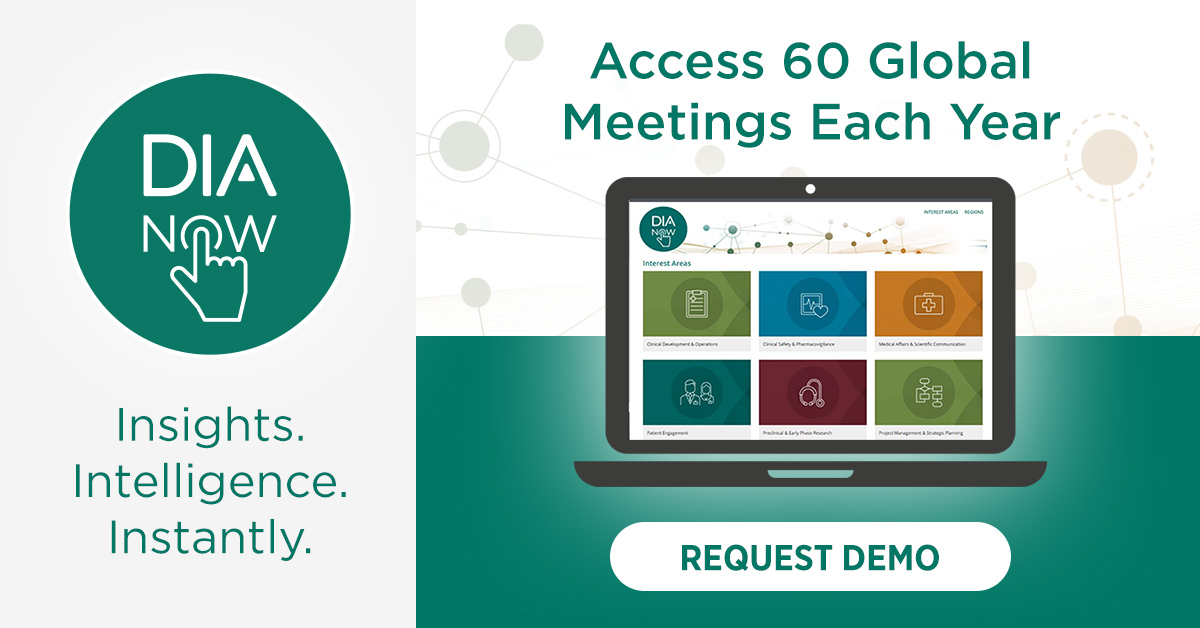May 2020 Global Forum
Table of Contents
EXECUTIVE LEADERSHIP
Subscribe
Love Global Forum‘s new online format? Subscribe today and never miss an issue.
Editorial Board
Content stream editors
Gary Kelloff US National Institutes of Health
David Parkinson ESSA Pharma, Inc.
regulatory science
Yoshiaki Uyama Pharmaceuticals and Medical Devices Agency (PMDA)
Adora Ndu BioMarin Pharmaceutical, Inc.
Patient engagement
Deborah Collyar Patient Advocates In Research (PAIR)
Lode Dewulf Servier
VALUE AND ACCESS
Monika Schneider Duke-Margolis Center for Health Policy
Editorial Staff
Alberto Grignolo, Editor-in-Chief Parexel International
Ranjini Prithviraj, Global Associate Director, Content Collaboration DIA Publications
Sandra Blumenrath, Science Writer DIA Publications
Chris M. Slawecki, Senior Digital Copyeditor DIA Publications
Regional Editors
David Mukanga Bill and Melinda Gates Foundation
ASEAN
Silke Vogel Duke-National University of Singapore Medical School
AUSTRALIA/NEW ZEALAND
Richard Day University of New South Wales, Medicine, St. Vincent’s Hospital
CANADA
Judith Glennie JL Glennie Consulting, Inc.
Megan Bettle Health Canada
CHINA
Ling Su Shenyang Pharmaceutical University, Lilly Asia Ventures
Europe
Thomas Kühler Sanofi R&D
INDIA
J. Vijay Venkatraman Oviya MedSafe
JAPAN
Akiko Ikeda Janssen Pharmaceutical K.K.
MIDDLE EAST
Inas Chehimi Novartis
USA
Ebony Dashiell-Aje BioMarin
Young Professionals Editor
DIA Membership
Bringing together stakeholders for the betterment of global health care.
How a Pandemic Accelerated the Adoption of Virtual Trials
Science 37
ike many others, I’ve spent the last four years trying to convince the biopharmaceutical industry that virtual or decentralized trials are the future of drug development. And that, if executed correctly, virtual trials maintain the same level of patient safety and high-quality data that are the cornerstones of traditional, site-based research. Society has arrived at a point at which the powerful mobile device we carry in our pocket—that we use to do everything from ordering our morning cup of coffee to buying a house—can be the tool that dismantles several of the barriers that have historically plagued clinical research.
![]() Podcasts
Podcasts
The Challenging Economics of Vaccine Development in the Age of COVID-19, and What Can Be Done About It
Brown University
Brown Center for Biomedical Informatics
QLS Advisors LLC
QLS Advisors LLC
The MITRE Corporation
MIT
QLS Advisors LLC
Santa Fe Institute
he recent destructive outbreak of the novel coronavirus, SARS-CoV-2, that emerged from Wuhan, China, and rapidly spread to Europe and North America, demonstrates beyond doubt that emerging infectious diseases (EIDs) are a clear and present danger to the world and its economy.
Uncontrolled outbreaks of EIDs can devastate populations around the globe, both in terms of lives lost and economic value destroyed. Emerging and re-emerging strains of infectious disease have become more diverse over time, and outbreaks have become more frequent. In 2006, Larry Brilliant stated that 90 percent of the epidemiologists in his confidence agreed that there would be a large pandemic—in which 1 billion people would sicken, 165 million would die, and the global economy would lose $1-3 trillion—within two generations. In 2020, this remarkable statement is playing out with each passing day.
Medical Writing: The Language and Art of Scientific Communication
CSOFT Health Sciences
edical writing is a scientific skill that writers deploy to author a multitude of documents addressing the needs of diverse and demanding stakeholders. This requires not only a deep understanding of therapeutic areas, regulations, and document types, but also soft skills such as strong negotiation skills and project management skills. The ability to present data and communicate the desired message is just one of those skills. This article describes different types of writers who author documents aimed at different objectives, including regulatory submissions, publications, safety, and medico-marketing.
Medical writers (MWs) are professionals from diverse backgrounds who address different business needs. Writers hone their skills over the years and master the art of digesting voluminous and complex information and presenting it in a succinct and objective manner. The diversity of the target audience, and thus the distinct differences in the objectives of scientific communication, poses a significant challenge. Balance this with the need to ensure regulatory compliance, prioritize patient safety, and manage the diverse views of multiple stakeholders from diverse therapeutic areas, and the challenge becomes even more daunting. Finally, the writer also needs to have expertise in evolving tools and technologies, deal with different style guides and increasingly complex and diverse document types, and ultimately deliver a strategically thought-out high-quality document on time.
![]() Podcasts
Podcasts
Around the Globe
Tigermed Co., Ltd.
n March 30, after six rounds of seeking public comments over the last several years, the State Administration for Marketing Regulation (SAMR) issued the revised Drug Registration Regulation (DRR), which will be put into effect on July 1, 2020. This is not only the first revision since the current version implemented thirteen years ago, but also a revision with significant changes to support enforcement of the 2nd revision of Drug Administration Law and the newly enacted Vaccine Administration Law, both of which became effective on December 1, 2019.
Around the Globe
Xu Wang
Novo Nordisk (China) Pharmaceuticals Co., Ltd.
BeiGene, Ltd.
n 2019, China’s National Medical Products Administration (NMPA) granted marketing approvals to 34 new chemical drugs and 19 biological products. Among the approvals, oncology drugs, anti-inflammatory drugs, and drugs for the immune system are the top three therapeutic areas.
Around the Globe
A European Perspective
Thomas Kühler
Sanofi R&D
colleague of mine recently told me she was maybe more overwhelmed by the COVID-19 news flow than by the actual virus itself. This resonated with me. Of course, it is good to learn that her health was not affected by the virus, but the time and effort required to keep abreast of the COVID-19 news flow was well reflected in one word: overwhelming.
Health Authorities around the globe continue to issue numerous guidelines related to managing the COVID-19 pandemic, and there are no signs that the news stream will dry up anytime soon. In the EU alone, many documents have already been issued addressing diverse and wide-ranging topics such as procurement of medicines, how to best conduct clinical trials to generate evidence on COVID-19 treatments, and free scientific advice to stimulate the development of new pharmaceutical principles.
![]() Podcasts
Podcasts
Around the Globe
Changing the Game in Oncology Development
DIA Global Oncology Development 2020
Novartis Pharma K.K.
he world surrounding cancer treatment continues to evolve rapidly. Emerging products now include immuno-oncology drugs and other new regenerative medicine and medical device therapies which further expand therapeutic choices in cancer treatment. Thanks to rapidly evolving digital applications, such as artificial intelligence (AI) and the Internet of Things (IoT), and their impact on clinical trial operations, clinical development in oncology faces both challenges and opportunities in keeping the evaluation of novel therapeutic products simple and reliable.
Around the Globe
Re-Evaluating the Need for Comparative Clinical Studies
t’s been ten years since the enactment of the Biologics Price Competition and Innovation Act, which created a new approval pathway for biosimilar products in the US. This new pathway was touted as a critical way to provide broader access to cost-effective biological treatments and has contributed to 26 approved biosimilars for nine different reference products as of March 2020. While much has evolved since the legislation was introduced, what has remained relatively constant is the comparative clinical study (CCS) as a necessary gateway to support the approval of biosimilar products. However, with advances in analytical techniques, improved understanding of the relationship between protein structure and function, and an ever-increasing body of global biosimilar experience, it’s time to re-evaluate the consistent need for CCSs in the next decade of biosimilar development.







